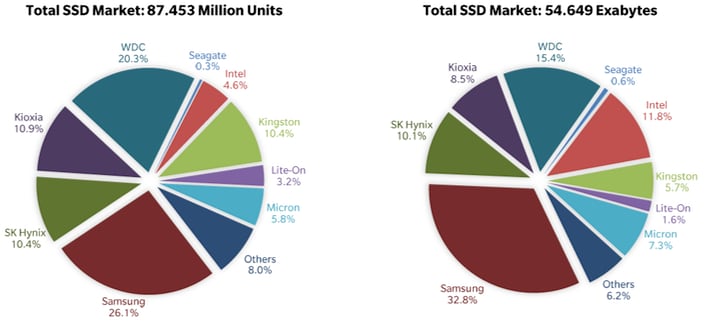SSDs Vastly Outsold HDDs During 2020 As Consumer PC Adoption Soars

Not surprisingly, the increase in PC shipments -- particularly with respect to laptops -- meant that that SSD volumes also skyrocketed. StorageNewsletter posted a note this week outlining that 333 million SSDs were shipped during 2020, compared to just 260 million HDDs. This represented a healthy 20.8 percent growth year-over-year for SSDs, while HDD shipments shrank by 18 percent.
The client SSD (consumer) market saw the biggest increases during the fourth quarter of 2020. Drive form factor (DFF) SSDs saw an 18 percent uplift quarter-over-quarter, while client M.2 SSDs increased 11 percent quarter-over-quarter. Enterprise SSDs, however, were the biggest loser, with a significant 31 percent decrease in shipments (which translated into a 34 percent reduction in shipped capacity).
"Enterprise SATA SSDs shipment declines reflected continued channel markets softness due to elevated inventories and reduced demand exiting the year," StorageNewsletter explained. "With majority of unit volumes and capacity utilized by the data center market, enterprise PCIe SSDs fell after 3 straight record quarters as hyperscale companies entered what expects to be a short digestion phase."
It should be noted, however, that while SSDs might have taken the shipment crown, HDDs are still far and away in the lead with respect to the total amount of storage capacity shipped during the same period. During all of 2020, the SSDs that were shipped represented 207 exabytes of storage capacity. Even though fewer HDDs were shipped, they accounted for five times the shipped storage capacity at roughly 1 zettabytes.
This will likely continue to be the case for a while for mass storage considering that consumer HDDs can be had in 16TB and 18TB capacities for around $500, while that same outlay will get you a 4TB PCIe SSD. However, NAND pricing has been trending downward, which has contributed to lower costs for SSDs. Many more laptops manufacturers are making SSDs standard across-the-board to enhance performance while making their devices thinner and lighter. It's becoming more common to see laptops with 256GB SSDs standard with affordable upgrades to 512GB and 1TB capacity for those that require additional storage breathing room.


